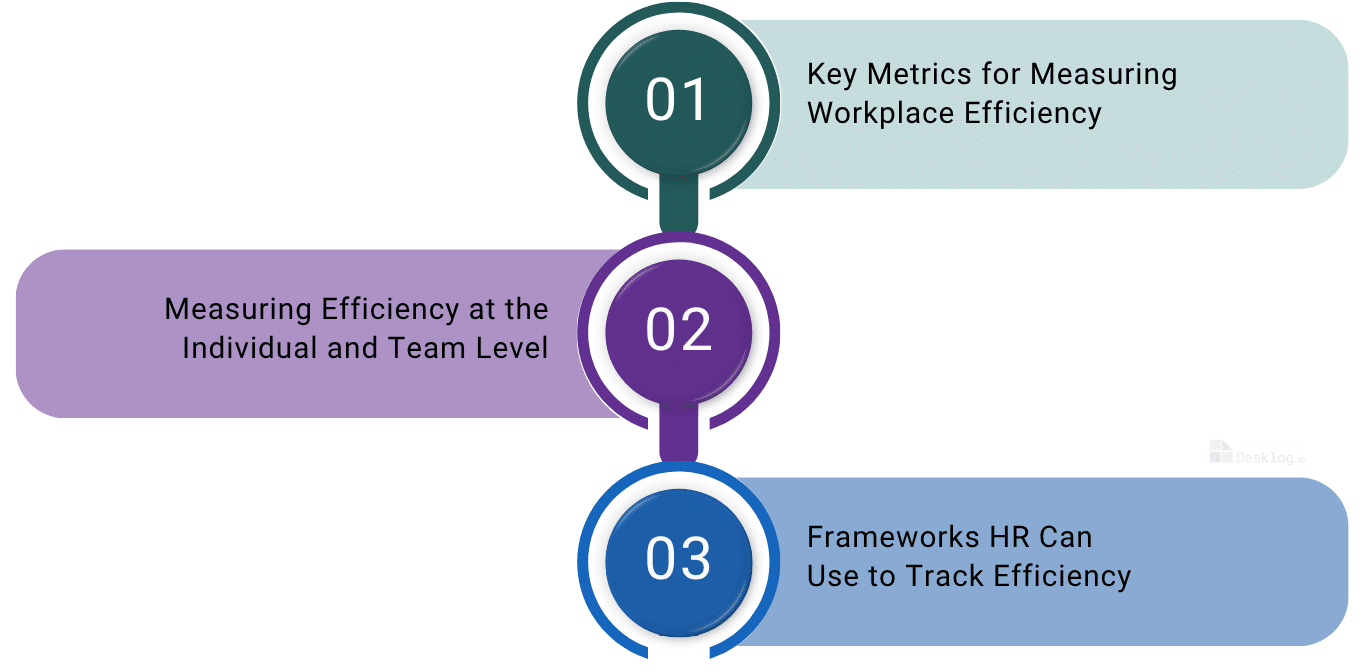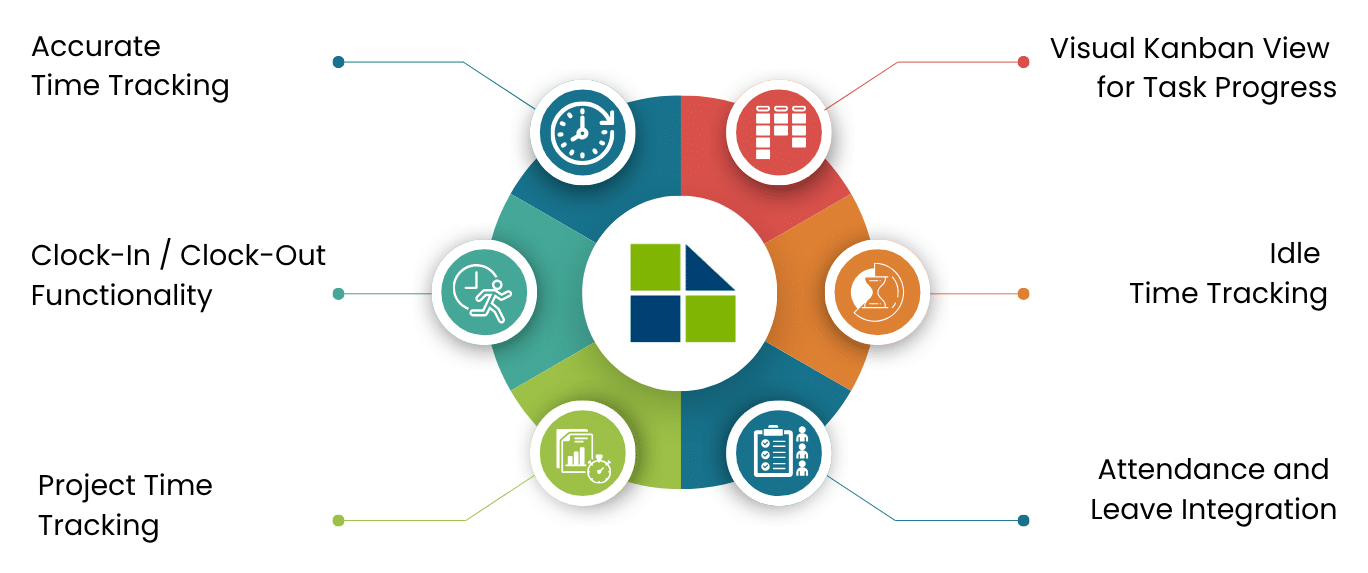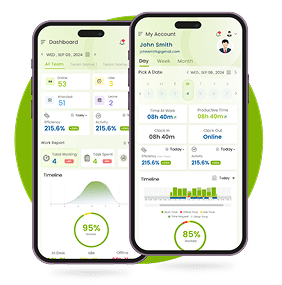According to a 2023 report by McKinsey, the average employee still spends nearly 60% of their time on work that adds little or no value, despite advances in technology and management practices. This widespread inefficiency leads to missed deadlines, employee burnout and billions in lost productivity every year.
So how can HR leaders, managers, and teams combat this? It starts with understanding what workplace efficiency really means, what’s getting in the way, and most importantly, how to fix it with tools like time tracking software to frameworks like OKRs and SMART goals.
In this blog, we’ll explore:
-
What Is Workplace Efficiency and Why It Matters
-
How HR Managers Can Measure and Track Efficiency
-
What Stops Teams from Working Efficiently
-
15 Proven Strategies to Improve Work Efficiency
-
Tools and Software That Can Help
-
FAQs for Quick Help
Let’s get right into it!
What Is Work Efficiency?
Workplace efficiency is completing tasks effectively while minimizing the waste of time, effort, and resources. It’s about achieving desired outcomes using the least amount of input possible, whether that be time, labor, money, or materials.
Efficient workplaces are characterized by simplified processes, clear communication and a strong focus on productivity without employee burnout or redundancies.
Difference Between Efficiency and Effectiveness
Although often used interchangeably, efficiency and effectiveness are not the same:
-
Efficiency is about how well you do something; using fewer resources to achieve the same outcome.
-
Effectiveness is about what you accomplish; reaching the desired goal, regardless of the effort required.
Common Misconceptions About Workplace Efficiency
| Misconception | Reality |
|---|---|
| Efficiency means rushing through work | True efficiency involves maintaining quality while minimizing waste, not cutting corners. |
| Efficiency comes from working longer hours | Longer hours can actually reduce productivity due to fatigue and burnout. |
| Technology alone guarantees efficiency | Tools are only effective when supported by good processes and trained people. |
| Only individual performance affects efficiency | Team collaboration, leadership, workflow design and culture all impact efficiency. |
| Being busy equals being efficient | High activity doesn’t always mean valuable output. |
Why Improving Efficiency in the Workplace Matters (Especially in 2025)
In 2025, the pace of business continues to accelerate, and organizations are under more pressure than ever to do more with less. Whether you’re managing a fully remote team, a hybrid workforce, or an in-office operation, efficiency affects everything from your bottom line to your employee experience.
The High Cost of Workplace Inefficiency
Inefficiency can be extremely costly, both financially and operationally:
-
$7 trillion is lost globally each year due to unproductive work time, according to Gallup research.
-
Employees spend over 20% of their time on tasks that could be automated (McKinsey).
-
Poor communication alone costs businesses an average of $12,506 per employee per year (Forbes).
-
Inefficient processes lead to missed deadlines, duplicated efforts, and poor project outcomes, often without teams even realizing it until it’s too late.
These figures highlight how improving workflows, minimizing manual tasks, and better communication can lead to substantial cost savings.
How Efficiency Impacts Productivity and Team Morale
Efficiency doesn’t just impact what gets done; it impacts how people feel while doing it:
-
Productive teams are more confident, motivated and engaged because their efforts produce clear, measurable results.
-
Inefficient systems lead to frustration, employee disengagement and burnout, especially when employees feel like they’re wasting time or being blocked by outdated processes.
-
Empowering employees with tools and workflows that remove bottlenecks not only improves output, but also improves overall job satisfaction.
A productive workplace environment demonstrates respect for employees’ time and effort, improving retention and cultivating a culture focused on performance.
Why Remote and Hybrid Teams Depend on Efficiency
The rise of remote and hybrid work has made workplace efficiency more critical than ever:
-
Asynchronous communication and flexible hours require teams to rely more on well-defined workflows and clear documentation.
-
Distributed teams can’t afford misalignment as poor visibility into projects or responsibilities can create massive slowdowns.
-
The adoption of collaboration tools and AI-powered automation has surged, helping teams work smarter across time zones and locations.
-
In 2025, companies are increasingly investing in data analytics and productivity tools to track and improve performance at both the individual and team levels.
Efficiency is no longer just about optimizing time. It’s about making hybrid work actually work by aligning people, tools, and processes.
How HR Managers Can Measure Efficiency in the Workplace

Measuring efficiency is about understanding how well time, talent, and tools are being used to produce results. HR managers play an important role in setting the standards and systems that reveal true performance while supporting productivity and employee well-being.
Key Metrics for Measuring Workplace Efficiency
To effectively measure workplace efficiency, HR managers should focus on performance-based and behavior-based metrics such as:
| Metric | Description |
|---|---|
| Output per Employee | Total deliverables or results produced in a specific time frame. |
| Task Completion Rate | Number of completed tasks versus assigned tasks. Often tracked via project management tools. |
| Active Time vs. Idle Time | Insights into actual working time compared to total logged hours. |
| Time to Completion | Duration taken to complete recurring tasks or projects. Helps identify workflow delays. |
| Error/Rework Rate | High rework rates suggest quality or communication issues affecting efficiency. |
These metrics provide HR with a more accurate picture of productivity than simply monitoring attendance or logged hours.
Measuring Efficiency at the Individual and Team Level
Efficiency should be assessed on both micro and macro levels, each offering unique insights:
| Level of Assessment | Focus Areas | Key Insights |
|---|---|---|
| Individual Efficiency Tracking | Coaching opportunities, workload distribution, time management | Helps identify personal productivity gaps and support needs |
| Team Efficiency Tracking | Collaboration quality, communication flow, collective output | Ideal for spotting workflow bottlenecks and improving overall team performance |
Frameworks HR Can Use to Track Efficiency

HR teams can apply the following frameworks to build reliable and insightful efficiency-measurement systems:
-
OKRs (Objectives and Key Results): Align individual and team outputs with broader business goals.
-
KPIs (Key Performance Indicators): Track quantifiable data like task duration, absenteeism, and goal achievement rates.
-
Time and Motion Studies: Analyze how tasks are performed and how time is allocated to uncover workflow inefficiencies.
-
360-Degree Feedback Combined with Output Metrics: Integrate peer, manager, and self-assessments with performance data for a well-rounded view.
-
Productivity Software Dashboards: Time and productivity tracking tools provide real-time dashboards to track progress, deadlines, and workloads.
What Stops Teams from Working Efficiently?
Even the most talented teams can struggle with efficiency when key obstacles stand in the way. These workplace distractions can be obvious or hidden beneath the surface. Understanding these issues is the first step toward solving them.
Constant Notifications & Digital Distractions
Slack pings, email overload, and app-switching can break focus and reduce deep work time. According to studies, it can take 23 minutes to refocus after a distraction.
Unclear Roles and Responsibilities
When team members aren’t sure who owns what, tasks fall through the cracks or get duplicated. Ambiguity leads to delays, rework, and frustration.
Tech Fatigue & App Overload
Using too many disconnected tools causes confusion and cognitive fatigue. Employees often toggle between 10+ apps daily, draining mental energy.
Meeting Overload
Back-to-back meetings can eat up hours without offering value. Many meetings lack agendas or clear takeaways, contributing little to progress.
Lack of Psychological Safety
If team members don’t feel safe to speak up, raise concerns, or ask questions, small problems go unaddressed until they become big ones.
Micromanagement and Low Trust
Excessive oversight can stifle ownership, creativity, and initiative, all of which help increase efficiency. High-performing teams are built on trust and autonomy.
Poor Workflow Design
Inefficient processes, redundant approvals, etc. lead to unnecessary delays. If workflows aren’t documented or visible, people make up their own, leading to inconsistency.
Lack of Alignment with Goals
Without a shared understanding of what matters most, teams focus on the wrong tasks or move in different directions.
15 Proven Strategies to Improve Work Efficiency
Increasing efficiency is about refining workflows, building better habits, and utilizing the right tools. Here are 15 ways to improve efficiency in the workplace:
Personal Productivity Hacks to Work More Efficiently
Time Boxing for Structured Focus
Schedule your day into time boxes for deep work, admin tasks, and breaks. This helps reduce multitasking and is one of the best ways to be more efficient at work.
Use the 80/20 Rule (Pareto Principle)
Make use of the pareto principle and focus on the 20% of activities that give 80% of results. This is key when learning how to work more efficiently.
Build High-Performance Habits
Small habits like starting your day with a priority list or ending with a review ritual can dramatically improve your effectiveness at work.
Pomodoro Technique to Maintain Energy
Work in 25-minute focus intervals with 5-minute breaks. This method is perfect for people wondering how to be efficient at the workplace without burning out.
Team Collaboration Improvements for Workplace Efficiency
Create and Share SOPs
Standard Operating Procedures remove ambiguity and keep everyone on the same page, which is vital for improving efficiency in the workplace.
Embrace Asynchronous Collaboration
Asynchronous work changes the game completely for remote and hybrid teams seeking ways to improve efficiency in the workplace.
Visual Workflow Boards
Kanban boards help teams track progress and eliminate blockers which is critical if you want to learn how to work in an office efficiently.
Cut Low-Value Meetings
Reduce meeting load to create more time for focused work which is one of the fastest ways to make company work more efficient.
Leadership & Policy Changes That Drive Efficiency
Set SMART Goals for Teams
SMART (Specific, Measurable, Achievable, Relevant, Time-bound) goals provide clarity and accountability, improving efficiency in the workplace.
Promote Flexibility in Work Styles
Allowing employees to choose their work hours or methods supports improving efficiency in the workplace while boosting morale.
Clear, Consistent Communication
Transparent leadership ensures teams are aligned which is one of the best strategies to improve work efficiency at a company-wide level.
Automation and AI Tools for Better Efficiency Tracking
Automate Repetitive Tasks
Use automation tools to simplify repetitive workflows. This is one of the most scalable ideas to improve workplace efficiency.
Use AI for Smart Workflows
Use AI to summarize meetings, draft content, or analyze feedback, which is ideal for anyone learning how to be more efficient at work.
Use Software That Tracks Workers’ Efficiency
Employee time tracking softwares help in tracking efficiency of workers by tracking time spent on tasks, active work time, and productivity scores.
Analyze and Iterate Based on Data
Learn how to calculate efficiency of a worker using performance metrics. Refine your processes regularly based on real insights, not assumptions.
How Desklog Helps You Work More Efficiently
Desklog is a powerful time tracking software designed to help businesses accurately track employee work hours and therefore improve employee productivity and focus.
By automating time capture and providing detailed insights into how work hours are spent, Desklog enables managers to optimize workflows, improve project tracking, and track work efficiency.
Key Features of Desklog

1. Accurate Time Tracking
-
Improves Time Accountability: Automatic time tracking logs exact login and logout times to ensure accurate tracking of work hours.
-
Detailed Productivity Insights: Distinguishes between productive work, idle time, and personal activities, giving managers a clear picture of how time is spent.
-
Optimizes Labor Costs: Tracks total hours worked, including overtime, enabling more precise payroll and better resource planning.
2. Clock-In / Clock-Out Functionality
-
Simplifies Attendance Tracking: Captures clock-in and clock-out data automatically, reducing manual errors and increasing efficiency in tracking work hours.
-
Ensures Accurate Overtime Logging: Real-time data helps avoid unrecorded extra hours, ensuring employees are fairly compensated and workloads are balanced.
-
Supports Remote Work Efficiency: Offline tracking ensures time is logged even without internet access, supporting remote teams without compromising data accuracy.
3. Project Time Tracking
-
Improves Task and Time Allocation: Enables teams to track project time, allowing for better workload distribution and realistic deadlines.
-
Supports Billing Accuracy: Clearly separates billable and non-billable hours, improving client transparency and project profitability.
-
Links Time to Output: By connecting hours to deliverables, it encourages greater accountability and helps identify efficiency gaps in project workflows.
4. Visual Kanban View for Task Progress
-
Improves Task Visibility: Desklog Kanban view offers a visual overview of task statuses, allowing teams to track progress and prioritize efficiently.
-
Reduces Delays and Bottlenecks: Makes it easy to identify workflow issues early, helping managers address them before they impact overall productivity.
-
Improves Resource Allocation: Enables quick workload balancing to avoid burnout and maximize team efficiency.
5. Idle Time Tracking
-
Uncovers Unproductive Patterns: Detects periods of inactivity to help identify distractions or inefficiencies in daily routines.
-
Promotes Better Time Management: Tracking idle time encourages employees to stay focused and make better use of their working hours.
-
Reduces Overtime Reliance: Helps minimize unnecessary overtime by targeting and resolving the causes of wasted time.
6. Attendance and Leave Integration
-
Provides a Holistic View of Availability: Combines attendance and leave tracking to give managers a full picture of employee availability and efficiency.
-
Identifies Leave Patterns and Resource Gaps: Highlights trends in absences or time-off that may impact team performance, allowing for proactive staffing adjustments.
-
Improves Payroll and Efficiency Analysis: Smoothly integrates holiday and leave data into workforce analytics, enabling informed HR planning.
Conclusion
Workplace efficiency isn’t a one-time initiative. Rather, it’s an ongoing commitment to smarter processes and purposeful technology. Companies that fail to prioritize efficiency risk falling behind in both performance and employee satisfaction.
From time tracking tools like Desklog to frameworks like OKRs and SMART goals, the strategies covered in this guide offer practical ways to reduce wasted time and put out the best output without sacrificing well-being.
In 2025 and beyond, the most successful organizations won’t just do more. They’ll do more with less, and do it better. Now’s the time to invest in the systems, tools, and habits that make that possible.
Your Search For The Ultimate Employee Efficiency Tracker Ends Here.
FAQ
1 How can HR managers measure employee efficiency without micromanaging?
HR managers can measure efficiency in the workplace by focusing on outcome-based metrics like task completion rates, time to completion, and output per employee.
2What tools help improve efficiency at work?
Several software tools that track workers’ efficiency can dramatically increase productivity. Platforms like Desklog help track task progress, identify bottlenecks, and automate repetitive work, all key strategies for improving efficiency in the workplace without adding complexity.
3How do I improve effectiveness vs. efficiency?
To improve effectiveness at work, focus on doing the right tasks (goal alignment), while efficiency is about doing tasks right (workflow optimization). Use SMART goals for effectiveness, and time tracking or automation tools to become more efficient at work.
4What’s the best first step to improve productivity?
The best first step is to identify time-wasting activities. Conduct an audit using tools that track efficiency of workers and evaluate workflows. This sets a strong foundation for both efficiency and productivity in the workplace.
5 What are some ideas to improve workplace efficiency?
There are many ways to improve efficiency in the workplace, such as time blocking, automating repetitive tasks, using Kanban boards, and reducing unnecessary meetings.
6How can I be more efficient at work without burning out?
Use techniques like the Pomodoro method, task prioritization, and blocking time for deep work. These are proven ways to be more efficient at work while maintaining your energy and avoiding overwork.
7How can I make my office space more efficient?
To make office space more efficient, focus on decluttering, optimizing furniture layout, and introducing collaboration zones. Efficient physical environments support mental clarity and contribute to overall workplace efficiency.
8What are the best strategies to improve work efficiency?
Some effective strategies to improve work efficiency include setting SMART goals, reducing digital distractions, improving team communication, and automating routine tasks using AI and workflow tools.
9How do I calculate the efficiency of a worker?
To calculate efficiency of a worker, divide actual output by the expected output over a specific time period. Tools like Desklog help gather this data, offering insights into how employees spend their time and how they can work more efficiently.
10How do I make my company work more efficiently?
To make company work more efficient, align team goals with company objectives, optimize processes and adopt productivity tools. Use data from performance dashboards to continuously refine and improve how to work in an office efficiently at both the individual and organizational level.

















